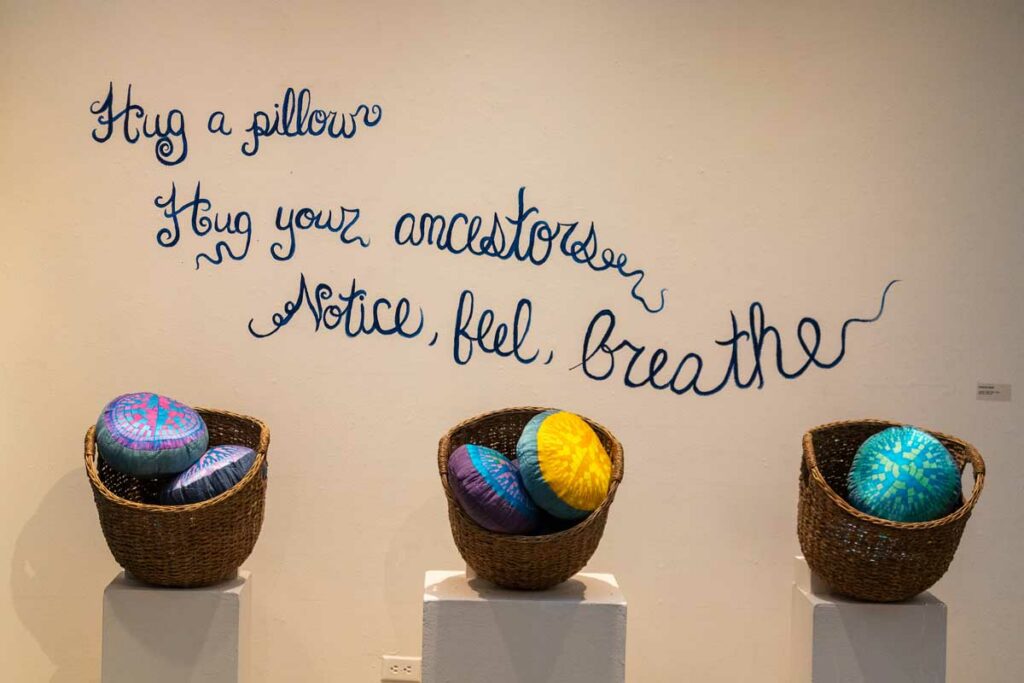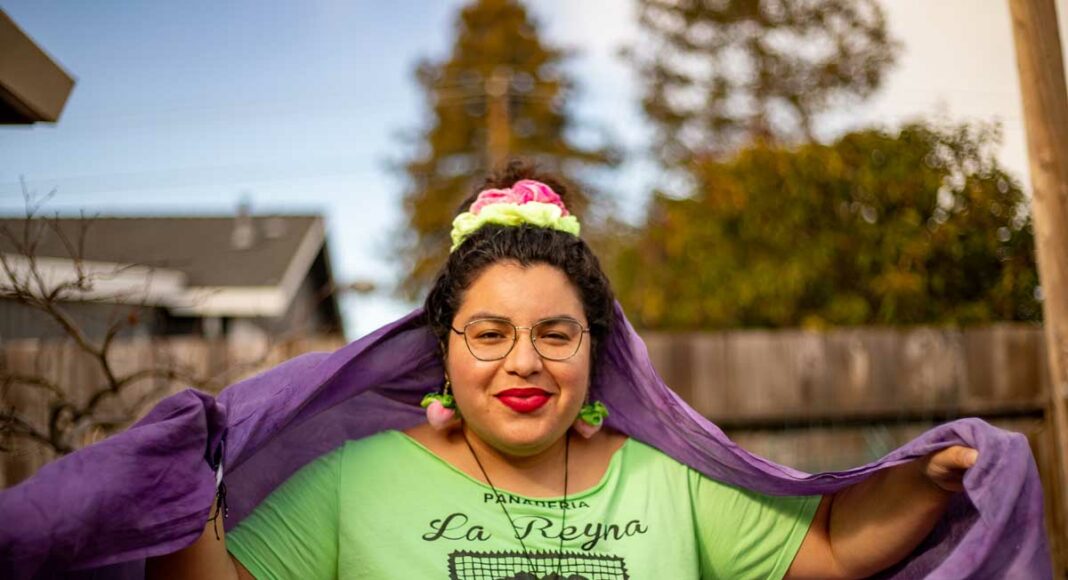Three woven baskets hold round pillows, each painted with a bright sun-like geometric design. On the wall behind them, scrawled in curly cursive, is the message, “Hug a pillow/ Hug your ancestors/Notice, feel, breathe.”
When she was a teen, Amanda Ayala’s middle school teacher took her to her first art museum in San Francisco. Ayala hated that she couldn’t touch the art.
Today, she loves museums, but longing to touch the art is still the hardest part, she says.
At Ayala’s first solo show, “Connected Always,” at the Richmond Art Center through March 18, this rule doesn’t apply. Guests are invited to touch her work.
A visit to Ayala’s home in Santa Rosa further reveals why she wants her art to be tactile.
Ayala lives with her sister and parents in the home where she was raised. Before we sat for an interview, she showed me the house, pointing out additions and upgrades her father has made.
The living room is a carport he converted. He added a covered patio. In the garden, dozens of plants he potted hang from structures he built.
“I consider my dad an artist and craftsperson. You can touch everything he makes,” Ayala says.
Ayala’s home overflows with her art-making. A few times during the conversation, she mentions appreciating her family’s support and permission to take up shared space in their house.
She speaks of her parents with tremendous love and admiration, even as she notes that living with them as an adult can be challenging.
“Connected Always” captures both Ayala’s youthful spirit and timeless wisdom, captivating her audience with an interactive, multimedia exhibition focused on one’s ancestors.
Praying Over Ancestors
Ayala’s interest in her own ancestors emerged after she began Aztec dancing more than 12 years ago.
“I started dancing in ceremonies as a way of praying and connecting with my community and with the spirits of my ancestors,” Ayala says.
Although she had limited knowledge of her own ancestor’s stories, the impact of one’s ancestors—both blood relatives and chosen family—was impressed upon her, as was the understanding that she will be an ancestor with an impact on generations going forward.
She has researched her own family history, but the stories she can find are limited. Ayala’s mother is a fourth-generation Xicana whose ancestors are Yaqui. Her father migrated from Michoacan to Mexico City and then to northern California in his late teens.
“I don’t have access to everything I would like to know. People who are targeted by different oppressions have different access to their ancestry,” Ayala says.

The Ancestor Wheel
A few years ago, Ayala saw an infographic about ancestral mathematics and wrote about it in a journal.
Many people would be embarrassed to share their personal journals even with close friends, but not Ayala. The journal in which she first started thinking about the ancestor wheel is on display at “Connected Always.”
To be fair, most people’s journals don’t look like Ayala’s, which combines diaristic writing and scrapbooking with collage and painting.
She hand-sews the pages together with big, visible seams, often creating books that fold like an accordion rather than with pages that turn. Her bookbinding techniques replicate and honor Mesoamerican books.
Ayala took the ancestry infographic she saw and started sketching what seven generations of parents would look like, depicted in a circle. Across seven generations, that’s 254 people.
Images similar to Ayala’s ancestor wheels are easy to find online, but always in the context of an infographic; they never make the leap to artistic design.
Ayala creates her wheels as complete circles, starting with two halves in the center to represent parents. Each previous generation fans out from this center. The result is an eye-catching abstract pattern reminiscent of a compass.
The image of the ancestor wheel repeats throughout Ayala’s exhibit.
“Soft Landing,” the largest wheel in the exhibit, is almost seven feet in diameter. A nod to the textile part of Ayala’s practice, it is made of a satin tablecloth and canvas tarp, sewn together with thread, stuffed with pillow fluff and dyed with pink and yellow fabric ink. It is in the center of a large wall in the gallery, with hundreds of hand-dyed silk pieces hanging around it.
On Instagram, Ayala shared a timelapse process video revealing what it took to make “Soft Landing.” The fabric is taped to the floor of her living room, filling almost the entire room as she sketches it. In the caption, she says that after a sleepless night spent stuffing it, she laid on top of it feeling grateful, exhausted and amazed.
Roberto Martinez, exhibitions director at Richmond Art Center, says that “Soft Landing” is one of the most popular parts of the show.
“The colors are rich, and it’s so big that I think it’s almost shocking to people when they enter,” Martinez says. “But then when you touch it, it allows you to land in this place of connection, surrounded by softness.”
Martinez met Ayala several years ago through Oakland’s Chiapas Support Committee (CSC), which educates about Chiapas and Zapatista communities through an annual festival of Zapatista art called CompArte.
When there was a CSC talk at California Institute of Integral Studies, Ayala created an altar that Martinez says set the tone for it.
“The altar was a space we could all connect around—to express honor and reverence for the land we’re on, and also for the energies we were bringing into the space,” Martinez says. “I thought it was pretty incredible.”
Ayala’s collaborators at CompArte knew about her ancestor wheel project. As he planned this winter’s exhibitions at Richmond Art Center, Martinez realized that “Connected Always” would be a great fit.
Alongside Ayala’s art, Richmond Art Center is showing a large annual group show, “Art of the African Diaspora and The Remembrance Project.” The latter, presented by Social Justice Sewing Academy, is described as, “a cloth memorial of activist art banners commemorating the many people who have lost their lives to systems of inequity and racist structures.”
Martinez says he is moved by Ayala’s ability to visualize the magnitude of interconnectedness.
“I thought Amanda’s ability to create space for us to show care for one another would work really well [alongside the other shows], which gets us thinking about our ancestors, our neighbors and people affected by systemic violence,” Martinez points out.
Recently, Ayala visited the show to meet with Martinez about an artist talk and journaling workshop that happened on Feb. 18.
A school teacher approached Ayala and told her that her students really loved the show. Their favorite part? They could touch the art.
‘Connected Always’ is on display through March 18 at Richmond Art Center. There will be a closing party on March 18 from 2-4pm. Admission is free. richmondartcenter.org.











